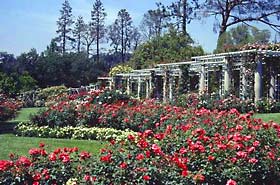
Henry Edwards Huntington purchased James DeBarth Shorb's San Marino ranch in 1903, flush with enthusiasm for the climate and the economic future of southern California. By age 53, Huntington had already made a fortune helping build the railroads to span the country. He moved to San Francisco in 1892, then to Los Angeles in 1902. There he built the electric railcars that linked the Los Angeles suburbs until the rise of the automobile and freeways, and he bought the Shorb ranch.
Although initially there was no grand vision, Huntington's passion for collecting books, art and plants was already well developed. Shortly the foundation for what would become the Huntington Library, Art Collections and Botanical Gardens was set. The nonprofit institution was founded in 1919.
Though some come close, there is still no place else like the Huntington in southern California, and there are few other public gardens in the United States you can visit mid-winter and expect comfortable weather and flowers. If you live in Los Angeles, you've likely been to the Huntington before. If you're planning a visit, for the Rose Bowl game, Rose Parade or to visit relatives, allow time for an afternoon at the Huntington.
The Gardens
The Botanical Gardens cover 130 acres of the 207-acre grounds. They include 15 gardens of special focus, all linked seamlessly with rolling lawns into the parklike grounds.
Make the Desert Garden the first stop on your winter visit. Located at the eastern edge of the gardens, this outdoor grouping of mature cacti and other succulents initially seems to be a mazelike jumble. Some plants look as if they were planted upside down, others droop and drape as though made of melting wax. It is an altogether otherworldly vision. More than 4,000 species comprise this landscape of plants from arid regions around the world. One of the most spectacular beds is composed mainly of densely planted pincushion cacti, Mammillaria geminispina and M. compressa. Among more than 200 aloes (many of them blooming now) are tree aloes, Aloe bainesii. These are about 50 years old and 30 feet tall. The array of golden barrel cacti, Echinocactus grusonii, is always a delight. Note the size of these and realize that it takes 30 years for one to grow only two feet tall.
The Huntington camellias are another winter specialty. The garden includes more than 1,300 named varieties of camellia on about 12 acres. The most striking views are along the west hillside adjacent to the Japanese Garden. The oldest specimen is a magnificent 'Pink Perfection', now almost 100 years old. Sasanqua camellias begin to bloom in November and December. Japonicas and reticulatas continue the show until early April.
Although not at their peak until mid-April, roses are in bloom here in January until the annual pruning is completed. The Rose Garden includes some 1,800 rose species and varieties. Arranged to trace the history of the rose from 450 B.C. to the present, this garden has at least one of every type of rose, old and new, including alba, bourbon, centifolia, China, damask, English, floribunda, gallica, grandiflora, hybrid musk, hybrid perpetual, hybrid tea, miniature, moss, noisette, polyantha, portland, rambler and tea.
There is much more: the specimen trees, bamboo, lily ponds, palms and the Australian garden, not to mention the botanical and rare book library and art collection.
The Huntington is southern California's climate at its best. This Mediterranean zone is one of only five regions in the world with modest rainfall that occurs in the winter. All Mediterranean areas are ocean influenced, subtropical and nearly frost free. One result of these similarities among the five regions has been to increase the number of plants gardeners can grow in each: The low-elevation California landscape is perfectly suited to the requirements of olive, cork oak and oleander from the Mediterranean, ice plant from South Africa, and eucalyptus from Australia. Thus, the Huntington Botanical Gardens is a distinctive patch in the ecological quilt that determines the character of southern California.
Location and Hours
The Huntington is located about 10 miles north of downtown Los Angeles at 1151 Oxford Rd., San Marino, California 91108. Call (626) 405-2141 for information or visit their website. Easiest access is via the Hill or Allen off ramps from the 210 freeway. Hours are 1 P.M. to 4:30 P.M. Tuesday through Friday, and from 10:30 A.M. to 4:30 P.M. Saturday and Sunday. It is closed on Mondays and major holidays. Admission is free, but a donation of $7.50 per adult, $6 per senior (65 years or more) and $4 for students and children (12 years and up) is requested. Free parking is ample; food is available at the patio restaurant. All gardens, except parts of the Japanese Garden, are wheelchair accessible.
Michael MacCaskey is a southern California native and was the editorial director at National Gardening. Photography by The Huntington Botanical Gardens
 Victory Seed Company has all the seeds you want for your best garden in 2024.
Victory Seed Company has all the seeds you want for your best garden in 2024.
For 25 years, the family-owned Victory Seed Company has provided the highest quality vegetable, herb and flower seeds to families across the country. We are passionate about providing you the best seeds available that give excellent germination, robust plants, and the harvest you want. With a catalog of over a thousand varieties, we have everything, and our prices are the kinds that we'd want to pay. We have hundreds of yesterday's heirloom vegetables, as well as today's award winning hybrid selections. Get to know us by visiting our website and browsing through our online vegetable seed catalog.